7 Variations Of Picadillo, Explained

Countries across Latin America and the Caribbean all have their own versions of it. Home cooks likely have their own interpretations, too. We're talking about picadillo, a full-flavored stew of ground meat and tomato. Ingredients vary by place, but the preparation is generally the same across borders: Sauté your aromatics, brown your meat, add your tomatoes, and let the dish simmer until fragrant. It's customizable: Use beef or pork, add spices, or sub capers for olives without veering too far from the soul of the dish. Though there are murmurs of versions unique to Peru, St. Lucia, and other Latin American and Caribbean countries, here we're highlighting the most distinct variations we've found on a dish whose passport has likely been stamped more times than your own.
While no one truly knows where picadillo originated, it's clear the dish has traveled alongside the Spanish language for several hundred years — its name comes from the Spanish verb "picar" (to mince), which references the method used to prep the meat before it's simmered in a base of aromatic vegetables. From there, it's any cook's game: Raisins may make an appearance, and the same can be said for eggs. While serving a starch alongside — say, plantains, rice, or beans — transforms the dish into a full meal, it's also considered more broadly to be a preparation style for ground meat, and its use as an ingredient in stuffed pastries and casserole dishes points to picadillo's foundational role in Latin American and Caribbean cookery.
Read more: Tips You Need When Cooking With Ground Beef
Mexican
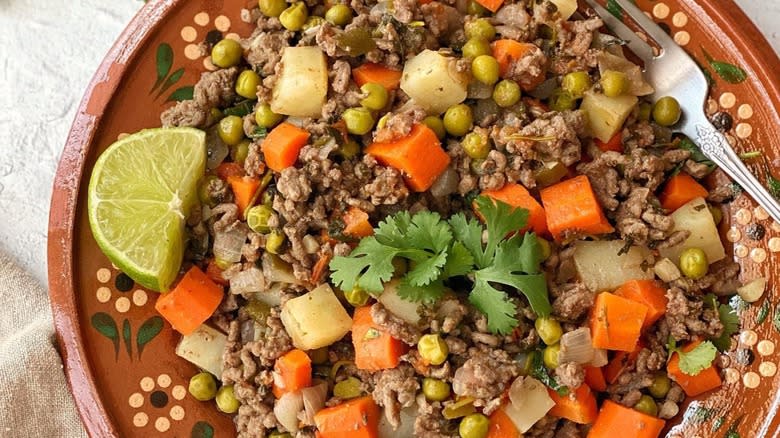
This is arguably the most well-known version of picadillo. (Mexican picadillo pulls in about 3.3 million search results compared to Cuban's 2.43 million). While ingredients may vary by region, it's largely beef-and-tomato-based. Tracking down the original recipe would be nearly impossible, but according to The Washington Post, early accounts note a version of the dish served to Mexican emperor Augustine de Iturbidein in the early 18th century stuffed into a poblano pepper, likely sparking nationwide affinity for the dish.
Modern adaptations are consistent with Agustín I of México's penchant for spice and heartiness, adding chile peppers (both red and green, depending on where you're enjoying your picadillo) for heat and starchy vegetables like potatoes and carrots for the body. A distinction between Mexican picadillo and other Latin American versions is how it is served, with fresh or fried tortillas (as is the case with tostadas de picadillo). While you'll see Central and South American countries using picadillo as a filling for empanadas, here it's perfectly content wrapped in tender masa for tamales de picadillo.
Cuban
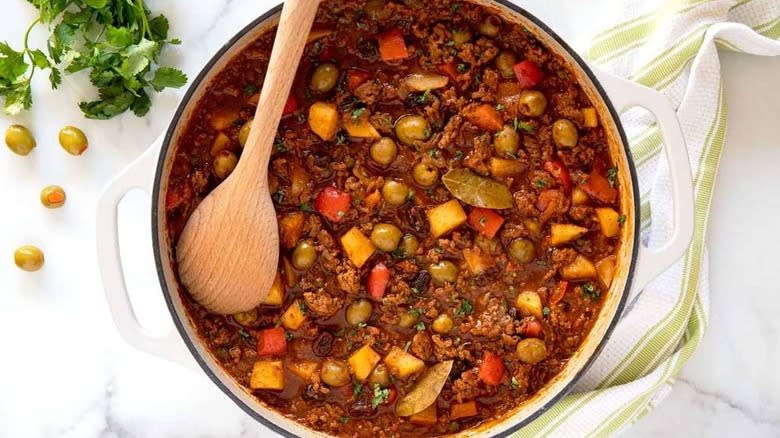
For some, picadillo conjures up images of a pre-revolutionary Cuba, a time when celebrities and socialites flocked to the country to sip on rum, eat hearty bowls of spiced stew, and forget their problems stateside. (In fact, Hemingway used to serve a version of picadillo to his guests at his home in Fibca, Vigia, Cuba.) For others, it's simply traditional comfort food at its best. According to The New York Times, recipes may have made their way to the United States via Cuban-American TV host and writer Nitza Villapol. Perhaps one of the reasons for picadillo's broad appeal is its versatility. Serve it as a main course for dinner topped with fried potato or diced yucca; warm it up as a filling for picadillo-stuffed poblano peppers the following lunch, then use any leftovers as a filling for empanadas. Just don't confuse it with arroz a la cubana — a simpler dish of white rice smothered in tomato sauce that's often meatless.
When you think of Cuba's version of the minced meat dish, think "tang." Depending on what the home cook likes to keep stocked, red or white wine or wine vinegar rounds out the acidity of a tomato base, while bay leaves, cumin, and cinnamon bring the dish back down to earth. Whereas Mexican interpretations commonly omit raisins, Cuban versions call for sweetness. If you're Ms. Hemingway, this sweetness comes from minced mango or peaches in addition to raisins, as documented in "The Hemingway Cookbook" by Craig Boreth.
Puerto Rican
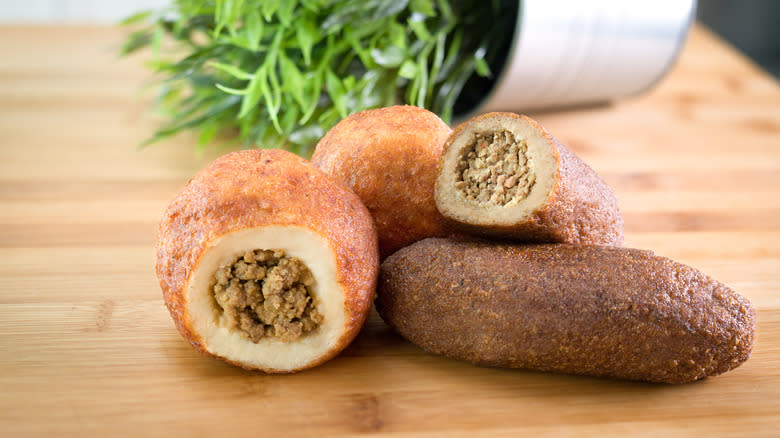
Puerto Rico's version of the meat-based stew combines elements of both Mexican and Cuban cooking with one distinction: its aromatic vegetable base. We start our storied dish with recaíto, a heady purée of green pepper, garlic, and onion, plus leaves of herby culantro ('recao' in Spanish). While Culantro is similar to tender-stemmed cilantro with an 'i' in application, it boasts a stronger flavor and grows abundantly in the Caribbean. The herb is also popular in Asian cooking. You'll find it by the bunch at Asian grocers like H Mart going by the name ngò gai. Cilantro can easily be substituted in most recipes that call for culantro.
Instead of Mexico's tortillas, you're more likely to find Puerto Rican picadillo served alongside rice and beans. Fried potatoes may be used as a garnish for texture. Similar to Cuba's version, Puerto Rican picadillo is used as a filling for empanadas, and also for the popular Puerto Rican appetizer called alcapurria, a type of fritter made from pounded green plantains and malanga, a tuber similar to cassava. The pounded malanga starch is dyed with annatto (the same seed used to color orange cheddar cheese) and wrapped around the picadillo. A Puerto Rican plantain casserole called pastelón also utilizes picadillo as a filling, layering the meat mixture between slices of green plantains like you would bolognese sauce in a lasagna.
Dominican
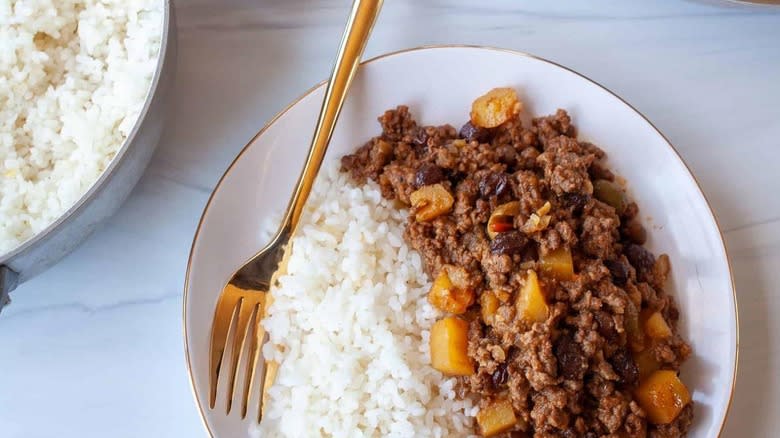
You're unlikely to find a dish called "picadillo" on menus across the Dominican Republic. Instead, the dish is referred to as carne molida — molida meaning "ground" in Spanish, and is served similarly to other versions of picadillo as both a dish and as a filling for dough-based recipes. Carne molida also relies on a base of recaíto, as well as the usual suspects: peppers, onions, tomato, even carrot. Tinned tomatoes are used, or if it's tomato season, fresh, blanched, and skinned ones that are chopped before being added to the cooked meat.
In the Dominican Republic, picadillo is used as a filling for cabbage rolls, called "niños envueltos" or swaddled children in Spanish — a nod to the dish's comforting nature and the shape the cabbage rolls take on once stuffed. It can also be stuffed into a pastry called piononos, a sweet and savory muffin-shaped appetizer where thin strips of caramelized plantain envelop a filling of picadillo and egg.
Costa Rican
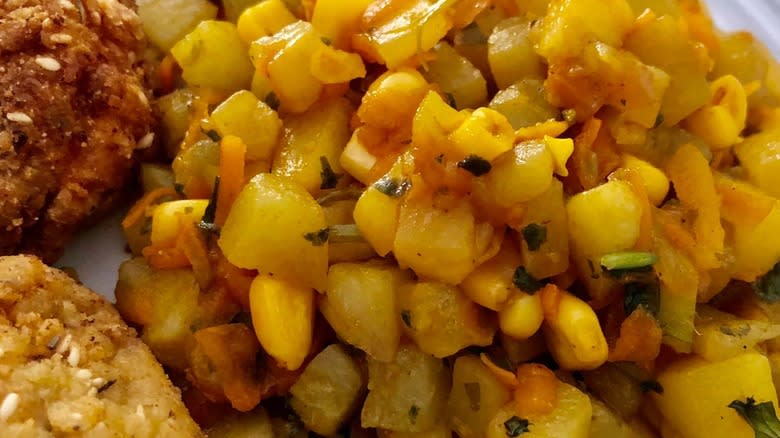
With a national motto of 'pura vida' and a fervent dedication towards environmental sustainability (more than 98% of the country's energy is renewable), it makes sense that Costa Rica has crowned a vegetarian version of the Latin American mainstay dish. While Costa Rican picadillo can still be found made with meat (typically ground beef), you're just as likely to find a version prepared with Chayote, an uncommon squash in North America, but one that's popular in Latin American and Asian cuisines. Called the vegetable pear by some, the mild-flavored chayote squash acts as a neutral base for soaking up the spicy-sweet notes characteristic of picadillo. Chayote squash is an important crop for Costa Ricans: The majority of the chayote consumed in the U.S. comes from Costa Rica and Mexico, respectively.
Picadillo de chayote is prepared differently than meat-based picadillo. A recipe native to San Ramon in the Central Valley of Costa Rica includes cream to marry the flavors. The chayote is steamed first until tender, then the lid of the pan is removed to let the squash's residual moisture evaporate, and to let the flavors concentrate. To up the umami quality of the vegetable-based dish, Picadillo de chayote occasionally utilizes a sauce called Salsa Lizano, which was introduced to the Costa Rican market in 1920 and is similar to English Worcestershire sauce. It's sweet, acidic, and slightly spicy without being cloying, adding depth to an otherwise mild vegetable.
Filipino
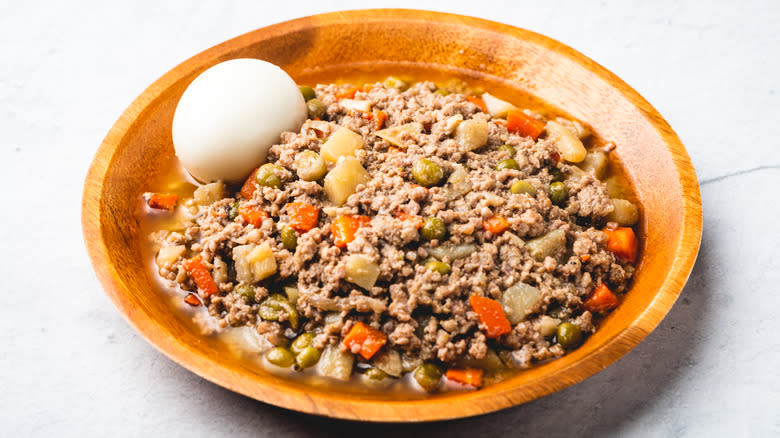
The Phillipines was considered a Spanish colony for nearly 300 hundred years, from the mid 16th century to the late 1800's. (Manila was founded as a Spanish city). As such, the country has retained some of its colonial influence which may explain why Filipino cuisine (and culture) is distinct from the bordering Southeast Asian countries of Thailand, Indonesia, and Vietnam. Giniling, a word which translates from Tagalog to English as "ground meat" is a Filipino dish strikingly similar to picadillo but seasoned more judiciously than its Latin American counterparts (and much of the cuisines of Southeast Asia.)
Despite toning down the spice, giniling leverages other high-impact ingredients like soy sauce – a nod to the dish's distinctly Asian identity. The base for ginilinig is similar to versions of picadillo, though raisins would seem foreign here, as would olives. Green peas make an appearance: for color, for texture, for that "pop" to contrast chewy bites of beef. Eggs are a consistent presence in giniling. Depending on what ingredients are available, quail eggs (commonly found in Filipino markets) are hardboiled and stirred into the dish. To circumvent the laborious task of peeling, home cooks will purchase them jarred and already peeled.
Spanish
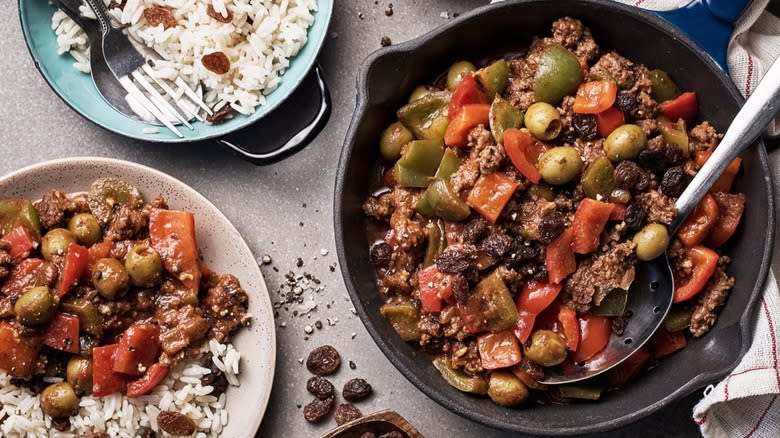
We'd be remiss not to mention picadillo's alleged forebear, Andalusia: a region south of the Iberian peninsula in Spain. Chef Gourmet surmises that Andalusia was the birthplace of Picadillo, which makes sense given the fact that the countries listed above are all former Spanish colonies. Though technically not its own country, Spain considers Andalusia to be a historical nationality, meaning that even over time, its people have retained a distinct, historically-defined identity — and thus cuisine. Since the Andalusians were one of the largest groups to settle in Latin America, it would make sense that they also brought with them a dish common to their kitchens.
Picadillo may have been inspired by Andalusia's interpretation of tapas, called "entremeses," whereby blanched meat, chopped veggies, and spices were combined to form a single, cohesive bite. One of the first documented recipes from Andalusia for a dish akin to picadillo consisted of a stew of chopped raw meat with bacon, vegetables, and garlic. The stew was then cooked and seasoned with spices and, for body, mounted with whisked egg. Olives are a distinctly Andalusian ingredient, as 25% of the land used for olive production worldwide still resides in Andalusia. Note how olives are featured across many versions of picadillo — further evidence of the dish's Spanish origins. Andalusia also has Arabic roots (this region of Spain was formerly called Al-Andalus), which may be how raisins, common to Middle Eastern cooking, found their way into the dish.
Read the original article on Tasting Table.

